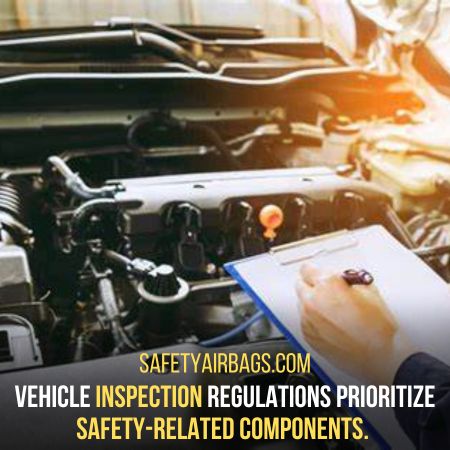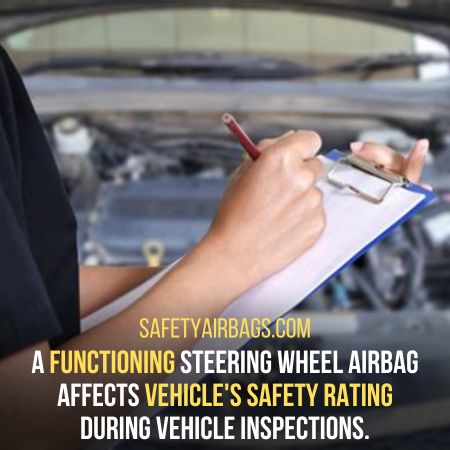Do you need a steering wheel airbag to pass inspection? Vehicle inspections ensure road safety and the well-being of drivers, passengers, and pedestrians.
What Will I learn
This article will delve into the regulations and requirements surrounding vehicle inspections. In addition, it will focus on the importance of safety-related components and the requirements for airbags.
Do You Need A Steering Wheel Airbag To Pass Inspection? Verdict
Yes, it would be best if you typically had a steering wheel airbag to pass vehicle inspections. Therefore, a functioning steering wheel airbag is an important safety requirement.
It helps protect the driver in a collision by reducing the risk of severe injuries. Vehicle inspection regulations often prioritize safety-related components.

For example, the steering wheel airbag is critical in ensuring occupant safety.
Vehicle Inspection Regulations and Requirements
Vehicle inspections are an essential aspect of ensuring road safety and maintaining the overall condition of vehicles.
These inspections are conducted to assess the compliance of vehicles with specific regulations and to identify any potential safety hazards.
Variations in Inspection Regulations Across Jurisdictions:
Vehicle inspection regulations can vary significantly across different jurisdictions.
While some regions may have stringent inspection standards, others may have more relaxed requirements.
These variations can encompass factors such as the frequency of inspections, the types of inspections conducted, and the specific components examined during the process.
Emphasis on Safety-Related Components:
Regardless of jurisdiction, one consistent aspect of vehicle inspections is emphasizing safety-related components.
These components are crucial for ensuring the vehicle’s and its occupants’ overall safety.
Inspections often include checks on the braking system, tires, lights, suspension, and steering system.
The integrity of the vehicle’s structure and body is also assessed to ensure it is free from damage or corrosion that could compromise safety.
Specific Requirements for Airbags During Inspections:
Airbags play a critical role in occupant safety during accidents. As such, inspections often include specific requirements for airbags.
These requirements typically focus on verifying vehicle airbags‘ presence, functionality, and condition.
In addition, inspectors will check if the vehicle has the appropriate airbags. It includes the front, side, or curtain, depending on the model and year of manufacture.
During inspections, the functionality of airbags is also assessed. This involves ensuring that the airbag system is not deactivated or tampered with. In addition, all necessary sensors and modules are checked for proper working.
In addition, inspectors may use diagnostic tools to retrieve any stored error codes or indicators related to the airbag system.
Moreover, the condition of airbags is examined to ensure they are not damaged or compromised in any way.
Any signs of deployment, such as torn or faded fabric, may indicate previous accidents or improper handling.
It could render the airbags ineffective. In such cases, repairs or replacements may be required for the vehicle to pass inspection.
Ensuring Compliance and Safety:
Vehicle inspections are important to ensure compliance with safety standards and regulations.
Inspectors help identify potential risks and enforce corrective measures. In addition, they enhance vehicle safety by emphasizing safety-related components, including airbags.
Vehicle owners must prioritize the maintenance and regular inspection of their airbag systems.
Timely repairs or replacements of faulty airbags are essential for passing inspections but also vital for the safety of vehicle occupants.
Neglecting or bypassing airbag requirements can expose occupants to increased risks in the event of an accident.
The Significance Of Steering Wheel Airbags In Inspections
Steering wheel airbags play a vital role in vehicle safety inspections, with their presence and functionality paramount:
Impact of Airbag Presence on Vehicle Safety Rating:
A functioning steering wheel airbag significantly affects the vehicle’s safety rating during vehicle inspections.
Airbags are considered a critical safety feature that helps protect drivers in a collision.

Their inclusion in the vehicle design demonstrates a commitment to occupant safety and compliance with safety standards.
Inspectors assess whether the airbag is installed correctly and in working condition. Their presence positively influences the vehicle’s overall safety rating.
Protection Offered by Steering Wheel Airbags in Accidents:
In the unfortunate event of a collision, steering wheel airbags provide crucial protection to the driver.
The airbag system deploys rapidly when the vehicle’s sensors detect a significant impact. It creates a cushioning barrier between the driver and the hard surfaces of the vehicle.
This mitigates the risk of direct contact between the driver’s head, chest, and the steering wheel, dashboard, or windshield, reducing the potential for severe injuries.
In addition, steering wheel airbags help absorb and distribute the forces generated during a crash. This minimizes the forward movement of the driver, enhancing overall occupant safety.
Role Of Airbags In Reducing The Risk Of Severe Injuries:
One of the primary objectives of vehicle inspections is to ensure the safety of occupants.
Steering wheel airbags play a critical role in achieving this goal by reducing the risk of severe injuries.
In frontal collisions, airbags help prevent or minimize head, chest, and upper body injuries by absorbing and dissipating the energy of the impact.
They act as a restraint system that complements seatbelts, enhancing occupant protection.
By rapidly deploying and cushioning the driver’s upper body, steering wheel airbags significantly reduce the potential for life-threatening injuries in accidents.
What Is A Steering Wheel Airbag
A steering wheel airbag is a crucial component of modern vehicle safety systems designed to protect drivers in the event of a collision.
A supplemental restraint system (SRS) works with other safety features, such as seatbelts. As a result, it mitigates a crash’s impact and reduces the risk of severe injuries.
Elements Of A Steering Wheel Airbag:
The steering wheel airbag is typically located in the center of the steering wheel. It consists of a fabric bag and an inflator module.
The bag is made of a durable material, usually nylon, designed to rapidly inflate upon sensing a significant impact.
Working Mechanism:
The inflator module contains a propellant, typically sodium azide. It produces a controlled chemical reaction.
This rapidly generates a large volume of inert gas, such as nitrogen, that fills the airbag.
When a collision occurs, the vehicle’s sensors detect the sudden deceleration or impact, sending signals to the airbag control module.
The module analyzes the data and determines the severity of the impact. If the impact exceeds a certain threshold, the module triggers the deployment of the steering wheel airbag.
The rapid inflation of the airbag occurs within milliseconds of impact. As a result, the bag expands outward towards the driver.

This serves as a cushioning barrier between the driver and the hard surfaces of the vehicle, such as the steering wheel, dashboard, or windshield.
This helps to absorb the energy of the impact and minimize the forward movement of the driver, reducing the risk of head, chest, and upper body injuries.
It is important to note that deploying the steering wheel airbag is a controlled event designed to protect the driver.
The bag starts deflating immediately after inflation to allow the driver to regain visibility and control the vehicle.
The deflation process is facilitated by small vents or openings in the airbag fabric, ensuring a gradual release of the gas.
Purpose And Function Of Airbags In Vehicles
Airbags in vehicles serve a crucial purpose in enhancing occupant safety during collisions.
They are designed to provide additional protection and mitigate the risk of severe injuries.
The primary function of airbags is to rapidly deploy and create a cushioning barrier between occupants and hard surfaces within the vehicle.
1. Collision Impact Mitigation:
The main purpose of airbags is to reduce the impact forces experienced by vehicle occupants during a collision.
When a crash occurs, sensors in the vehicle detect the sudden deceleration or impact and send signals to the airbag control module.
This triggers the deployment of airbags to absorb and distribute the forces exerted on the occupants, minimizing the risk of injuries.
2. Occupant Restraint Enhancement:
Airbags work in conjunction with seatbelts to enhance occupant restraint systems.
Seatbelts are responsible for preventing occupants from being ejected from the vehicle.
Airbags provide additional protection by reducing the forward movement of occupants and cushioning their impact with hard surfaces.
The combination of seatbelts and airbags offers a comprehensive approach to occupant safety.
3. Head And Chest Protection:
Airbags are particularly effective in protecting vehicle occupants’ head and chest areas.
In frontal collisions, front airbags in the dashboard shield the driver and front passenger’s upper bodies.

This reduces the risk of head and chest injuries caused by striking the steering wheel, dashboard, or windshield.
Side airbags protect in the event of a side impact, minimizing the risk of head and torso injuries.
4. Energy Absorption:
The inflation of an airbag creates a controlled cushioning effect that absorbs and dissipates the energy generated by a collision.
By absorbing the impact forces, airbags help slow down the occupants’ deceleration.
They reduce the risk of serious injuries, such as traumatic brain or spinal injuries.
5. Secondary Impact Protection:
Airbags also provide secondary impact protection. Certain vehicles are equipped with a curtain or side-impact airbags in case of a rollover or subsequent collisions after the initial impact.
They deploy from the roof or side panels to protect the occupants from hitting the vehicle’s interior structures or other objects.
Conclusion:
In conclusion, steering wheel airbags are of immense significance in vehicle inspections.
This is due to their impact on vehicle safety ratings, their protection in accidents, and their role in reducing the risk of severe injuries.
Their presence and proper functionality contribute to higher occupant safety and compliance with safety standards.
Vehicle owners must prioritize the maintenance and inspection of their steering wheel airbags. This ensures their effectiveness in protecting drivers during collisions.
